Organisational Behaviour Report: Leadership Styles and Human Behavior
VerifiedAdded on 2020/01/15
|14
|4343
|178
Report
AI Summary
This report provides a comprehensive analysis of organisational behaviour, focusing on CAPCO and Morgan Stanley as case studies. It explores the importance of organisational behaviour in business operations, examining leadership styles (individual, democratic, laissez-faire), organisational culture, and the impact of internal and external factors on individual behaviour. The report delves into various management approaches, including empirical, human behavioural, social system, and decision theory approaches, comparing their application in both companies. Furthermore, it discusses motivational theories and their impact on employee performance, emphasizing the significance of a healthy work environment and effective communication. The report aims to identify patterns of human behaviour and their influence on organisational performance, offering valuable insights into leadership, management, and team effectiveness within financial service providers.
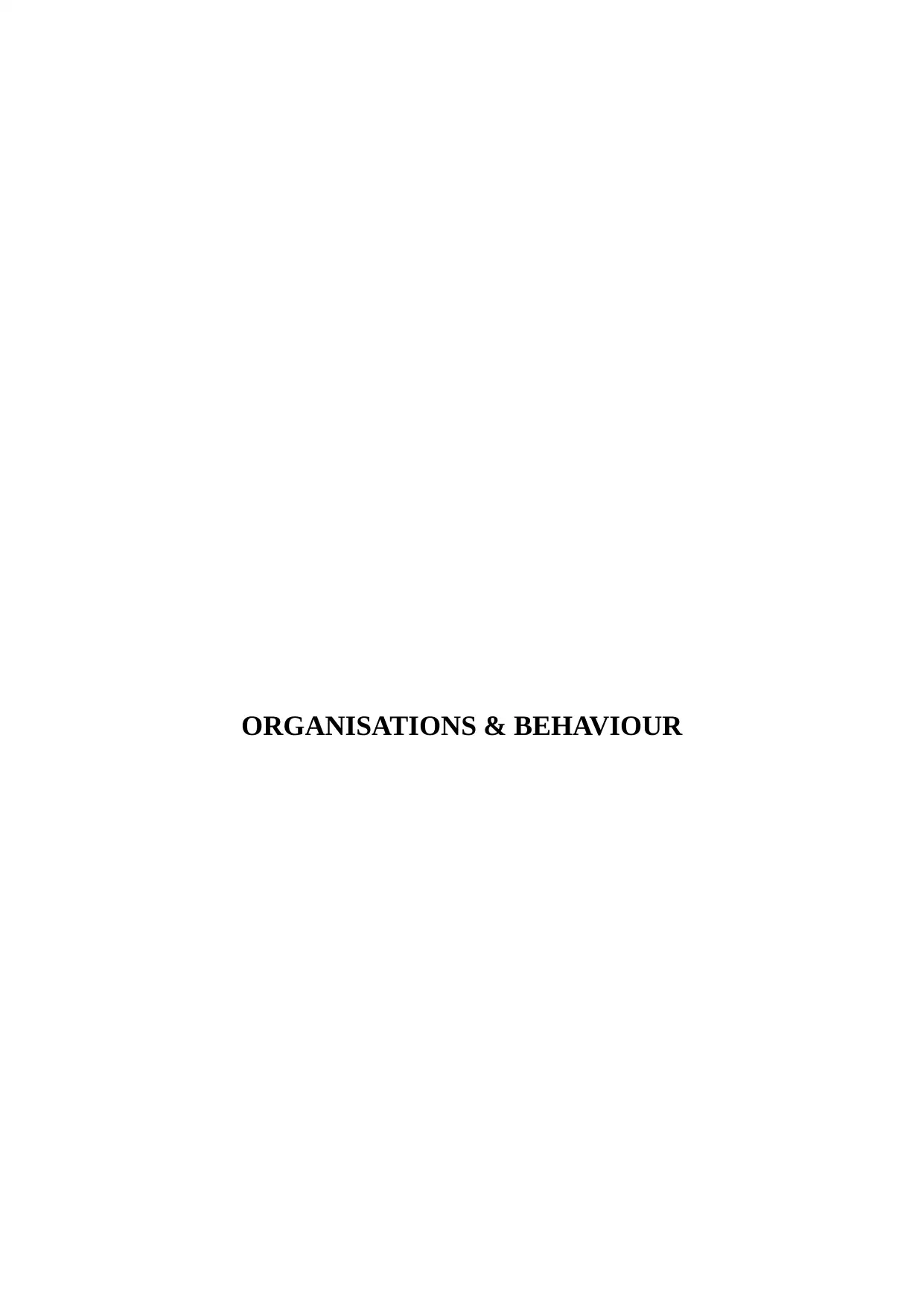
ORGANISATIONS & BEHAVIOUR
Paraphrase This Document
Need a fresh take? Get an instant paraphrase of this document with our AI Paraphraser
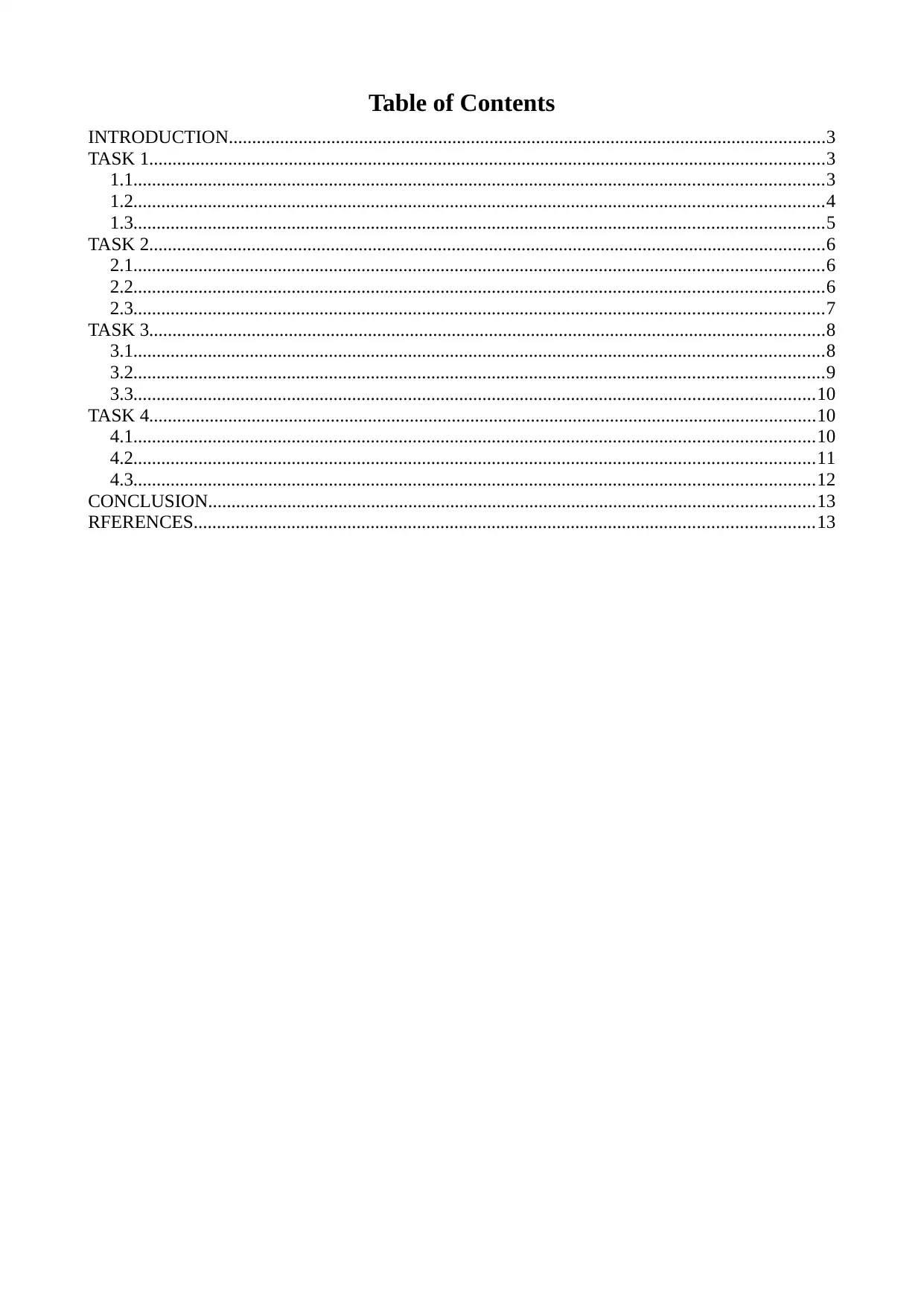
Table of Contents
INTRODUCTION................................................................................................................................3
TASK 1.................................................................................................................................................3
1.1....................................................................................................................................................3
1.2....................................................................................................................................................4
1.3....................................................................................................................................................5
TASK 2.................................................................................................................................................6
2.1....................................................................................................................................................6
2.2....................................................................................................................................................6
2.3....................................................................................................................................................7
TASK 3.................................................................................................................................................8
3.1....................................................................................................................................................8
3.2....................................................................................................................................................9
3.3..................................................................................................................................................10
TASK 4...............................................................................................................................................10
4.1..................................................................................................................................................10
4.2..................................................................................................................................................11
4.3..................................................................................................................................................12
CONCLUSION..................................................................................................................................13
RFERENCES.....................................................................................................................................13
INTRODUCTION................................................................................................................................3
TASK 1.................................................................................................................................................3
1.1....................................................................................................................................................3
1.2....................................................................................................................................................4
1.3....................................................................................................................................................5
TASK 2.................................................................................................................................................6
2.1....................................................................................................................................................6
2.2....................................................................................................................................................6
2.3....................................................................................................................................................7
TASK 3.................................................................................................................................................8
3.1....................................................................................................................................................8
3.2....................................................................................................................................................9
3.3..................................................................................................................................................10
TASK 4...............................................................................................................................................10
4.1..................................................................................................................................................10
4.2..................................................................................................................................................11
4.3..................................................................................................................................................12
CONCLUSION..................................................................................................................................13
RFERENCES.....................................................................................................................................13
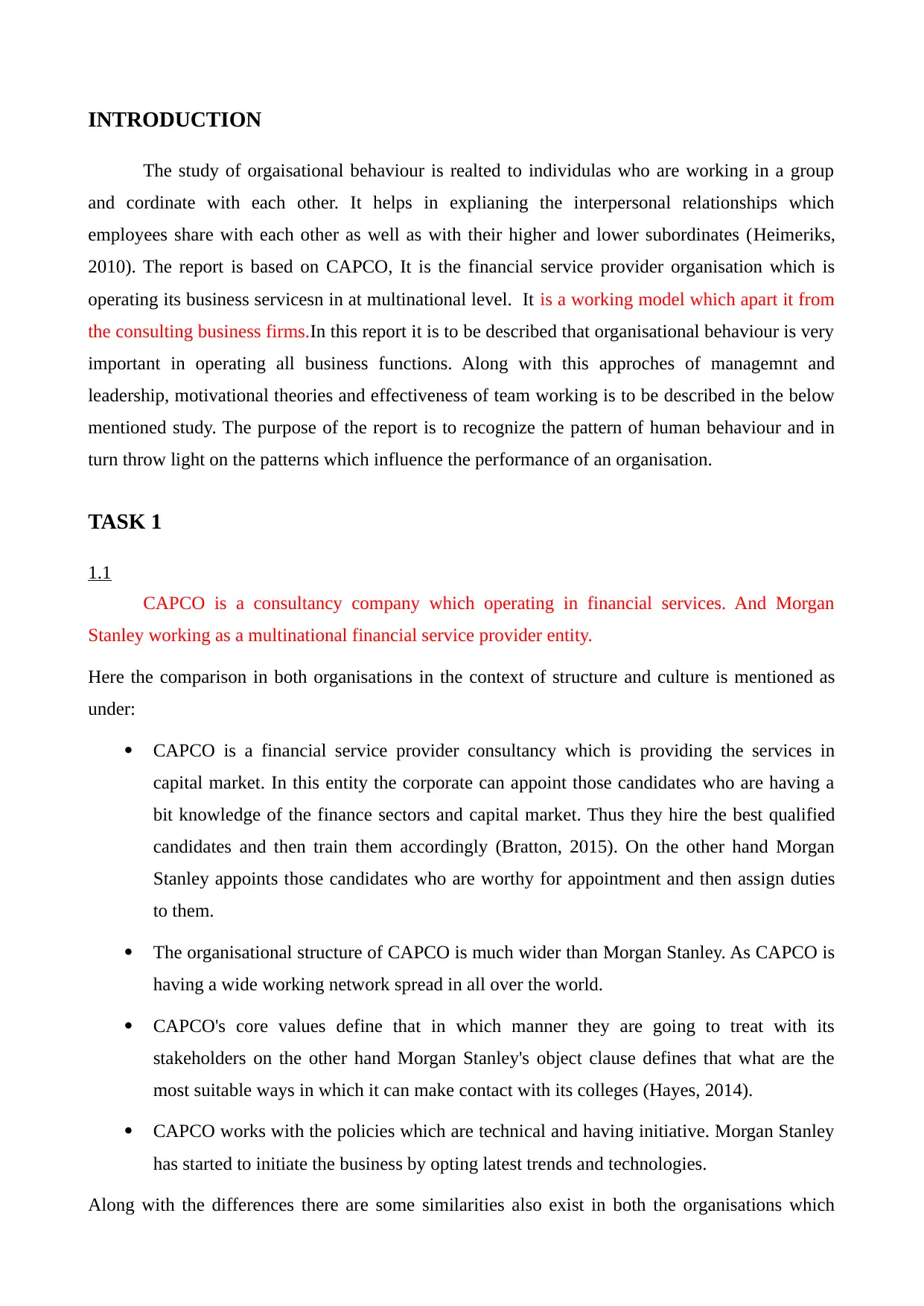
INTRODUCTION
The study of orgaisational behaviour is realted to individulas who are working in a group
and cordinate with each other. It helps in explianing the interpersonal relationships which
employees share with each other as well as with their higher and lower subordinates (Heimeriks,
2010). The report is based on CAPCO, It is the financial service provider organisation which is
operating its business servicesn in at multinational level. It is a working model which apart it from
the consulting business firms.In this report it is to be described that organisational behaviour is very
important in operating all business functions. Along with this approches of managemnt and
leadership, motivational theories and effectiveness of team working is to be described in the below
mentioned study. The purpose of the report is to recognize the pattern of human behaviour and in
turn throw light on the patterns which influence the performance of an organisation.
TASK 1
1.1
CAPCO is a consultancy company which operating in financial services. And Morgan
Stanley working as a multinational financial service provider entity.
Here the comparison in both organisations in the context of structure and culture is mentioned as
under:
CAPCO is a financial service provider consultancy which is providing the services in
capital market. In this entity the corporate can appoint those candidates who are having a
bit knowledge of the finance sectors and capital market. Thus they hire the best qualified
candidates and then train them accordingly (Bratton, 2015). On the other hand Morgan
Stanley appoints those candidates who are worthy for appointment and then assign duties
to them.
The organisational structure of CAPCO is much wider than Morgan Stanley. As CAPCO is
having a wide working network spread in all over the world.
CAPCO's core values define that in which manner they are going to treat with its
stakeholders on the other hand Morgan Stanley's object clause defines that what are the
most suitable ways in which it can make contact with its colleges (Hayes, 2014).
CAPCO works with the policies which are technical and having initiative. Morgan Stanley
has started to initiate the business by opting latest trends and technologies.
Along with the differences there are some similarities also exist in both the organisations which
The study of orgaisational behaviour is realted to individulas who are working in a group
and cordinate with each other. It helps in explianing the interpersonal relationships which
employees share with each other as well as with their higher and lower subordinates (Heimeriks,
2010). The report is based on CAPCO, It is the financial service provider organisation which is
operating its business servicesn in at multinational level. It is a working model which apart it from
the consulting business firms.In this report it is to be described that organisational behaviour is very
important in operating all business functions. Along with this approches of managemnt and
leadership, motivational theories and effectiveness of team working is to be described in the below
mentioned study. The purpose of the report is to recognize the pattern of human behaviour and in
turn throw light on the patterns which influence the performance of an organisation.
TASK 1
1.1
CAPCO is a consultancy company which operating in financial services. And Morgan
Stanley working as a multinational financial service provider entity.
Here the comparison in both organisations in the context of structure and culture is mentioned as
under:
CAPCO is a financial service provider consultancy which is providing the services in
capital market. In this entity the corporate can appoint those candidates who are having a
bit knowledge of the finance sectors and capital market. Thus they hire the best qualified
candidates and then train them accordingly (Bratton, 2015). On the other hand Morgan
Stanley appoints those candidates who are worthy for appointment and then assign duties
to them.
The organisational structure of CAPCO is much wider than Morgan Stanley. As CAPCO is
having a wide working network spread in all over the world.
CAPCO's core values define that in which manner they are going to treat with its
stakeholders on the other hand Morgan Stanley's object clause defines that what are the
most suitable ways in which it can make contact with its colleges (Hayes, 2014).
CAPCO works with the policies which are technical and having initiative. Morgan Stanley
has started to initiate the business by opting latest trends and technologies.
Along with the differences there are some similarities also exist in both the organisations which
⊘ This is a preview!⊘
Do you want full access?
Subscribe today to unlock all pages.

Trusted by 1+ million students worldwide
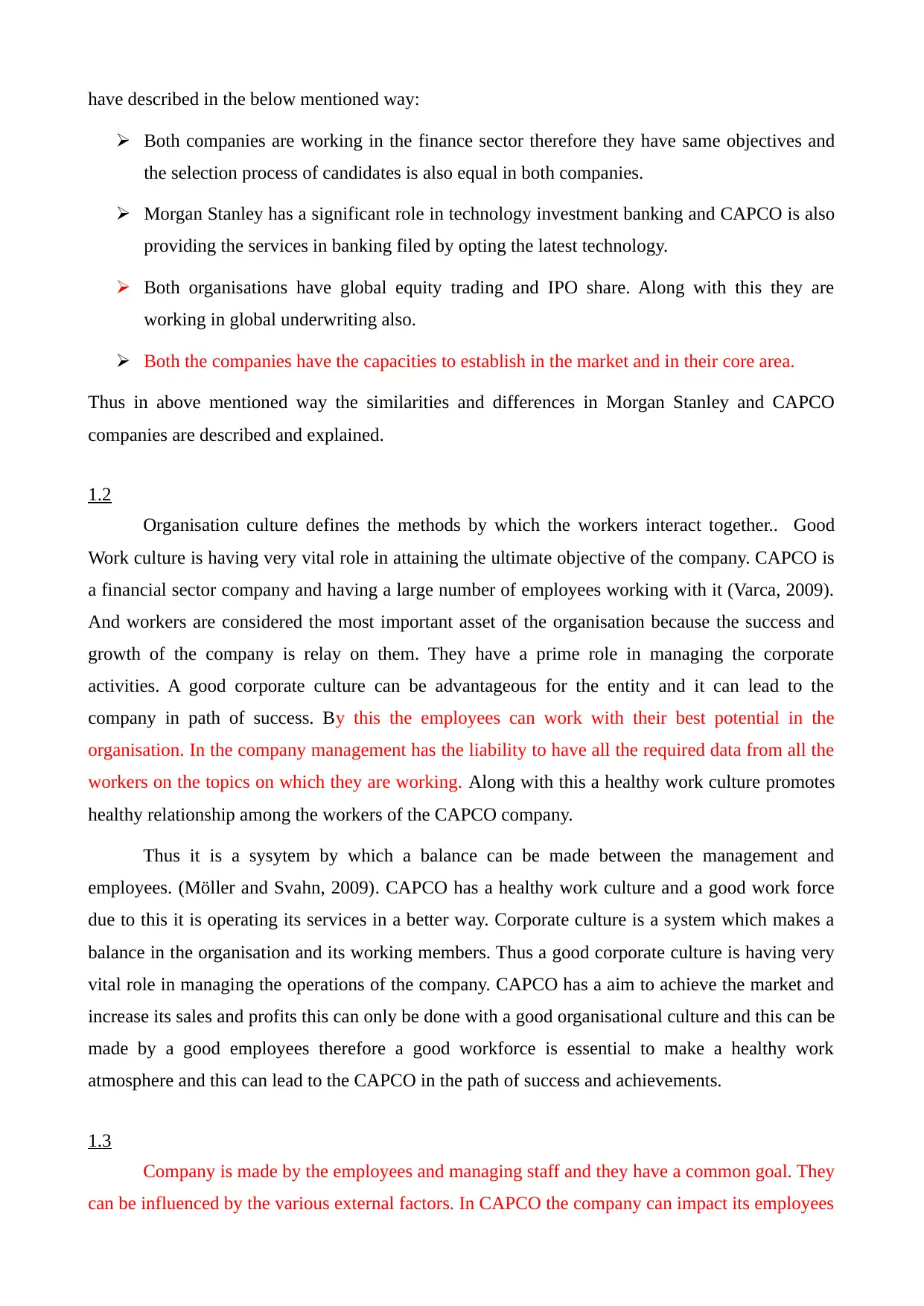
have described in the below mentioned way:
Both companies are working in the finance sector therefore they have same objectives and
the selection process of candidates is also equal in both companies.
Morgan Stanley has a significant role in technology investment banking and CAPCO is also
providing the services in banking filed by opting the latest technology.
Both organisations have global equity trading and IPO share. Along with this they are
working in global underwriting also.
Both the companies have the capacities to establish in the market and in their core area.
Thus in above mentioned way the similarities and differences in Morgan Stanley and CAPCO
companies are described and explained.
1.2
Organisation culture defines the methods by which the workers interact together.. Good
Work culture is having very vital role in attaining the ultimate objective of the company. CAPCO is
a financial sector company and having a large number of employees working with it (Varca, 2009).
And workers are considered the most important asset of the organisation because the success and
growth of the company is relay on them. They have a prime role in managing the corporate
activities. A good corporate culture can be advantageous for the entity and it can lead to the
company in path of success. By this the employees can work with their best potential in the
organisation. In the company management has the liability to have all the required data from all the
workers on the topics on which they are working. Along with this a healthy work culture promotes
healthy relationship among the workers of the CAPCO company.
Thus it is a sysytem by which a balance can be made between the management and
employees. (Möller and Svahn, 2009). CAPCO has a healthy work culture and a good work force
due to this it is operating its services in a better way. Corporate culture is a system which makes a
balance in the organisation and its working members. Thus a good corporate culture is having very
vital role in managing the operations of the company. CAPCO has a aim to achieve the market and
increase its sales and profits this can only be done with a good organisational culture and this can be
made by a good employees therefore a good workforce is essential to make a healthy work
atmosphere and this can lead to the CAPCO in the path of success and achievements.
1.3
Company is made by the employees and managing staff and they have a common goal. They
can be influenced by the various external factors. In CAPCO the company can impact its employees
Both companies are working in the finance sector therefore they have same objectives and
the selection process of candidates is also equal in both companies.
Morgan Stanley has a significant role in technology investment banking and CAPCO is also
providing the services in banking filed by opting the latest technology.
Both organisations have global equity trading and IPO share. Along with this they are
working in global underwriting also.
Both the companies have the capacities to establish in the market and in their core area.
Thus in above mentioned way the similarities and differences in Morgan Stanley and CAPCO
companies are described and explained.
1.2
Organisation culture defines the methods by which the workers interact together.. Good
Work culture is having very vital role in attaining the ultimate objective of the company. CAPCO is
a financial sector company and having a large number of employees working with it (Varca, 2009).
And workers are considered the most important asset of the organisation because the success and
growth of the company is relay on them. They have a prime role in managing the corporate
activities. A good corporate culture can be advantageous for the entity and it can lead to the
company in path of success. By this the employees can work with their best potential in the
organisation. In the company management has the liability to have all the required data from all the
workers on the topics on which they are working. Along with this a healthy work culture promotes
healthy relationship among the workers of the CAPCO company.
Thus it is a sysytem by which a balance can be made between the management and
employees. (Möller and Svahn, 2009). CAPCO has a healthy work culture and a good work force
due to this it is operating its services in a better way. Corporate culture is a system which makes a
balance in the organisation and its working members. Thus a good corporate culture is having very
vital role in managing the operations of the company. CAPCO has a aim to achieve the market and
increase its sales and profits this can only be done with a good organisational culture and this can be
made by a good employees therefore a good workforce is essential to make a healthy work
atmosphere and this can lead to the CAPCO in the path of success and achievements.
1.3
Company is made by the employees and managing staff and they have a common goal. They
can be influenced by the various external factors. In CAPCO the company can impact its employees
Paraphrase This Document
Need a fresh take? Get an instant paraphrase of this document with our AI Paraphraser
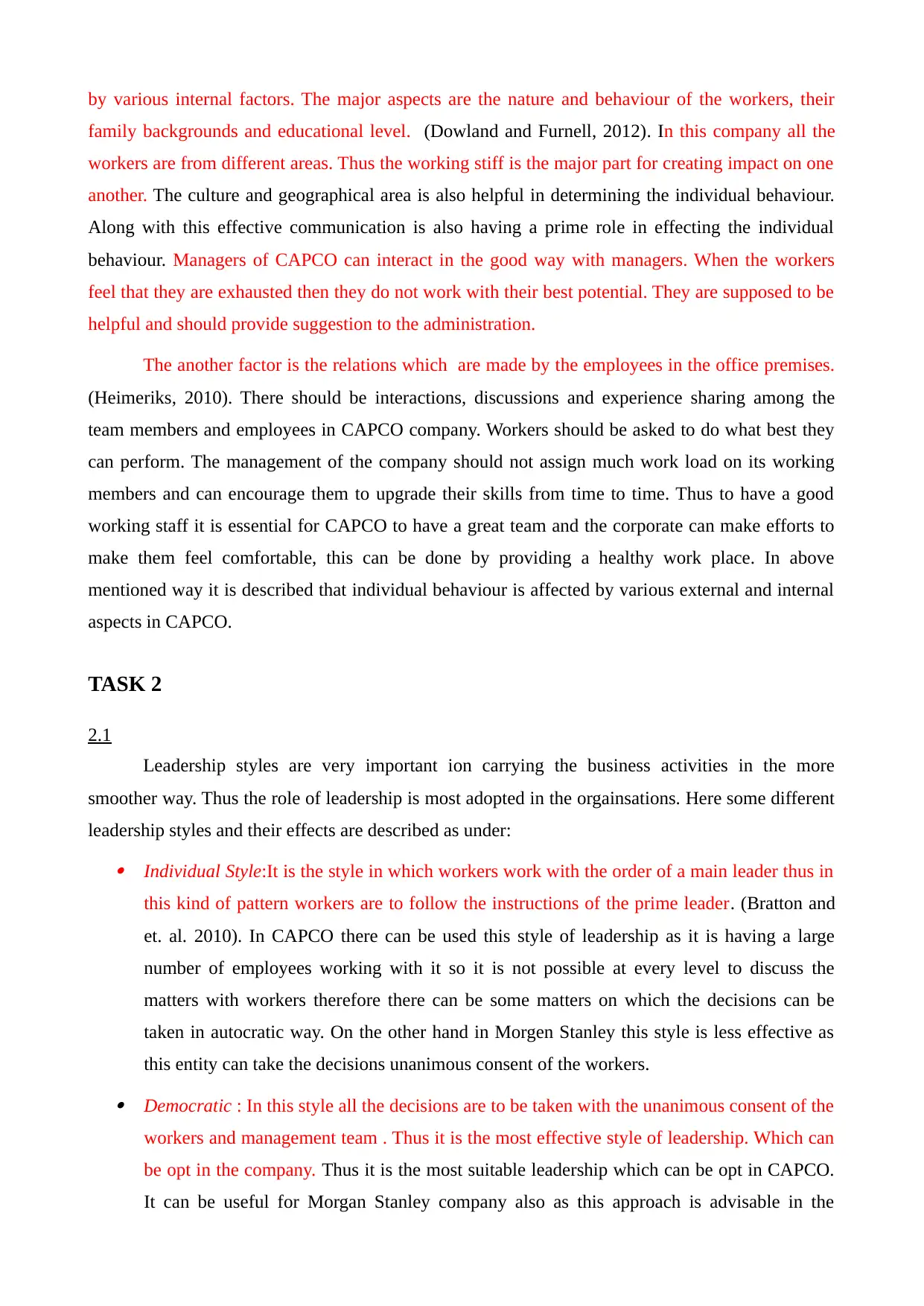
by various internal factors. The major aspects are the nature and behaviour of the workers, their
family backgrounds and educational level. (Dowland and Furnell, 2012). In this company all the
workers are from different areas. Thus the working stiff is the major part for creating impact on one
another. The culture and geographical area is also helpful in determining the individual behaviour.
Along with this effective communication is also having a prime role in effecting the individual
behaviour. Managers of CAPCO can interact in the good way with managers. When the workers
feel that they are exhausted then they do not work with their best potential. They are supposed to be
helpful and should provide suggestion to the administration.
The another factor is the relations which are made by the employees in the office premises.
(Heimeriks, 2010). There should be interactions, discussions and experience sharing among the
team members and employees in CAPCO company. Workers should be asked to do what best they
can perform. The management of the company should not assign much work load on its working
members and can encourage them to upgrade their skills from time to time. Thus to have a good
working staff it is essential for CAPCO to have a great team and the corporate can make efforts to
make them feel comfortable, this can be done by providing a healthy work place. In above
mentioned way it is described that individual behaviour is affected by various external and internal
aspects in CAPCO.
TASK 2
2.1
Leadership styles are very important ion carrying the business activities in the more
smoother way. Thus the role of leadership is most adopted in the orgainsations. Here some different
leadership styles and their effects are described as under:
Individual Style:It is the style in which workers work with the order of a main leader thus in
this kind of pattern workers are to follow the instructions of the prime leader. (Bratton and
et. al. 2010). In CAPCO there can be used this style of leadership as it is having a large
number of employees working with it so it is not possible at every level to discuss the
matters with workers therefore there can be some matters on which the decisions can be
taken in autocratic way. On the other hand in Morgen Stanley this style is less effective as
this entity can take the decisions unanimous consent of the workers.
Democratic : In this style all the decisions are to be taken with the unanimous consent of the
workers and management team . Thus it is the most effective style of leadership. Which can
be opt in the company. Thus it is the most suitable leadership which can be opt in CAPCO.
It can be useful for Morgan Stanley company also as this approach is advisable in the
family backgrounds and educational level. (Dowland and Furnell, 2012). In this company all the
workers are from different areas. Thus the working stiff is the major part for creating impact on one
another. The culture and geographical area is also helpful in determining the individual behaviour.
Along with this effective communication is also having a prime role in effecting the individual
behaviour. Managers of CAPCO can interact in the good way with managers. When the workers
feel that they are exhausted then they do not work with their best potential. They are supposed to be
helpful and should provide suggestion to the administration.
The another factor is the relations which are made by the employees in the office premises.
(Heimeriks, 2010). There should be interactions, discussions and experience sharing among the
team members and employees in CAPCO company. Workers should be asked to do what best they
can perform. The management of the company should not assign much work load on its working
members and can encourage them to upgrade their skills from time to time. Thus to have a good
working staff it is essential for CAPCO to have a great team and the corporate can make efforts to
make them feel comfortable, this can be done by providing a healthy work place. In above
mentioned way it is described that individual behaviour is affected by various external and internal
aspects in CAPCO.
TASK 2
2.1
Leadership styles are very important ion carrying the business activities in the more
smoother way. Thus the role of leadership is most adopted in the orgainsations. Here some different
leadership styles and their effects are described as under:
Individual Style:It is the style in which workers work with the order of a main leader thus in
this kind of pattern workers are to follow the instructions of the prime leader. (Bratton and
et. al. 2010). In CAPCO there can be used this style of leadership as it is having a large
number of employees working with it so it is not possible at every level to discuss the
matters with workers therefore there can be some matters on which the decisions can be
taken in autocratic way. On the other hand in Morgen Stanley this style is less effective as
this entity can take the decisions unanimous consent of the workers.
Democratic : In this style all the decisions are to be taken with the unanimous consent of the
workers and management team . Thus it is the most effective style of leadership. Which can
be opt in the company. Thus it is the most suitable leadership which can be opt in CAPCO.
It can be useful for Morgan Stanley company also as this approach is advisable in the
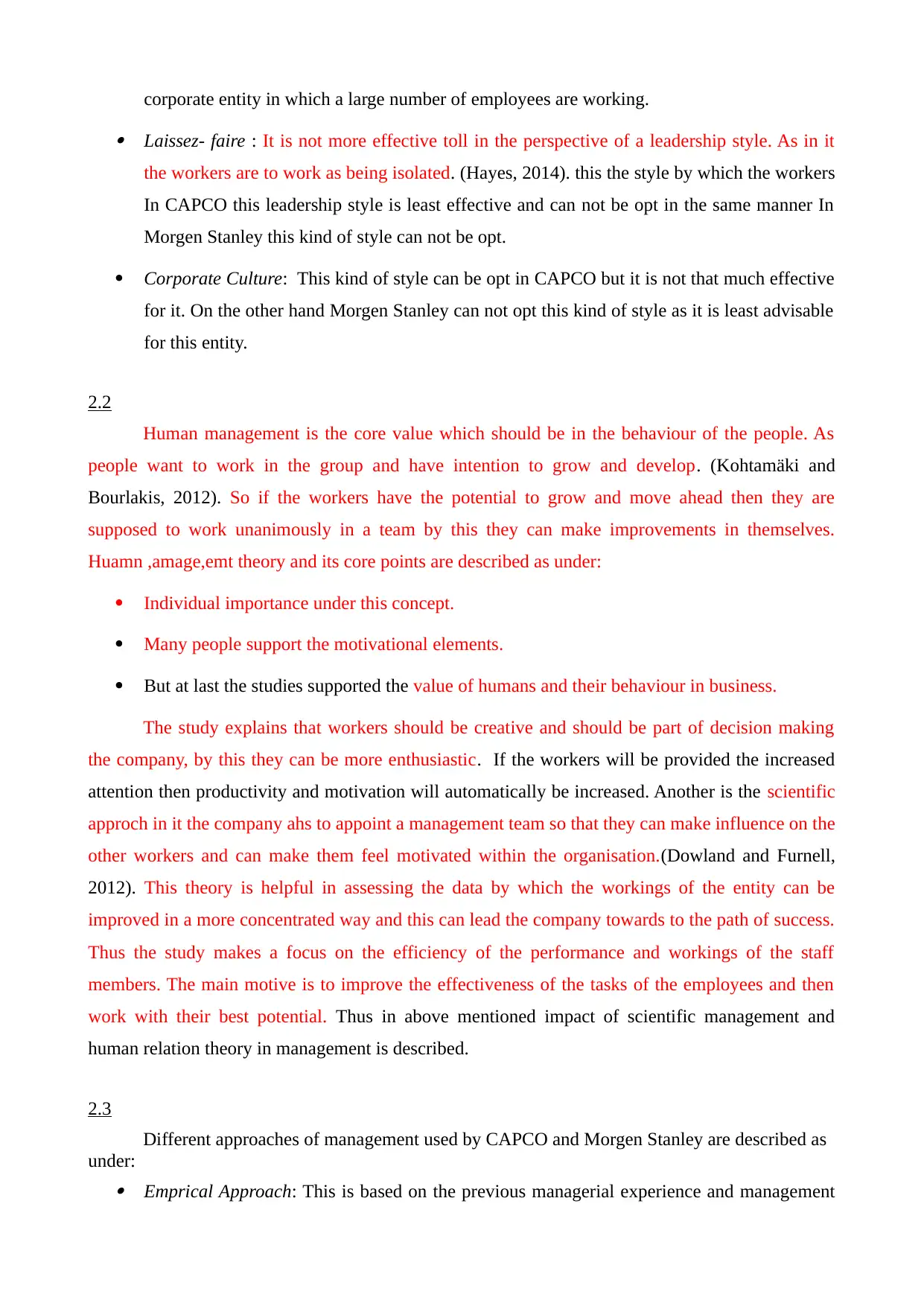
corporate entity in which a large number of employees are working.
Laissez- faire : It is not more effective toll in the perspective of a leadership style. As in it
the workers are to work as being isolated. (Hayes, 2014). this the style by which the workers
In CAPCO this leadership style is least effective and can not be opt in the same manner In
Morgen Stanley this kind of style can not be opt.
Corporate Culture: This kind of style can be opt in CAPCO but it is not that much effective
for it. On the other hand Morgen Stanley can not opt this kind of style as it is least advisable
for this entity.
2.2
Human management is the core value which should be in the behaviour of the people. As
people want to work in the group and have intention to grow and develop. (Kohtamäki and
Bourlakis, 2012). So if the workers have the potential to grow and move ahead then they are
supposed to work unanimously in a team by this they can make improvements in themselves.
Huamn ,amage,emt theory and its core points are described as under:
Individual importance under this concept.
Many people support the motivational elements.
But at last the studies supported the value of humans and their behaviour in business.
The study explains that workers should be creative and should be part of decision making
the company, by this they can be more enthusiastic. If the workers will be provided the increased
attention then productivity and motivation will automatically be increased. Another is the scientific
approch in it the company ahs to appoint a management team so that they can make influence on the
other workers and can make them feel motivated within the organisation.(Dowland and Furnell,
2012). This theory is helpful in assessing the data by which the workings of the entity can be
improved in a more concentrated way and this can lead the company towards to the path of success.
Thus the study makes a focus on the efficiency of the performance and workings of the staff
members. The main motive is to improve the effectiveness of the tasks of the employees and then
work with their best potential. Thus in above mentioned impact of scientific management and
human relation theory in management is described.
2.3
Different approaches of management used by CAPCO and Morgen Stanley are described as
under: Emprical Approach: This is based on the previous managerial experience and management
Laissez- faire : It is not more effective toll in the perspective of a leadership style. As in it
the workers are to work as being isolated. (Hayes, 2014). this the style by which the workers
In CAPCO this leadership style is least effective and can not be opt in the same manner In
Morgen Stanley this kind of style can not be opt.
Corporate Culture: This kind of style can be opt in CAPCO but it is not that much effective
for it. On the other hand Morgen Stanley can not opt this kind of style as it is least advisable
for this entity.
2.2
Human management is the core value which should be in the behaviour of the people. As
people want to work in the group and have intention to grow and develop. (Kohtamäki and
Bourlakis, 2012). So if the workers have the potential to grow and move ahead then they are
supposed to work unanimously in a team by this they can make improvements in themselves.
Huamn ,amage,emt theory and its core points are described as under:
Individual importance under this concept.
Many people support the motivational elements.
But at last the studies supported the value of humans and their behaviour in business.
The study explains that workers should be creative and should be part of decision making
the company, by this they can be more enthusiastic. If the workers will be provided the increased
attention then productivity and motivation will automatically be increased. Another is the scientific
approch in it the company ahs to appoint a management team so that they can make influence on the
other workers and can make them feel motivated within the organisation.(Dowland and Furnell,
2012). This theory is helpful in assessing the data by which the workings of the entity can be
improved in a more concentrated way and this can lead the company towards to the path of success.
Thus the study makes a focus on the efficiency of the performance and workings of the staff
members. The main motive is to improve the effectiveness of the tasks of the employees and then
work with their best potential. Thus in above mentioned impact of scientific management and
human relation theory in management is described.
2.3
Different approaches of management used by CAPCO and Morgen Stanley are described as
under: Emprical Approach: This is based on the previous managerial experience and management
⊘ This is a preview!⊘
Do you want full access?
Subscribe today to unlock all pages.

Trusted by 1+ million students worldwide
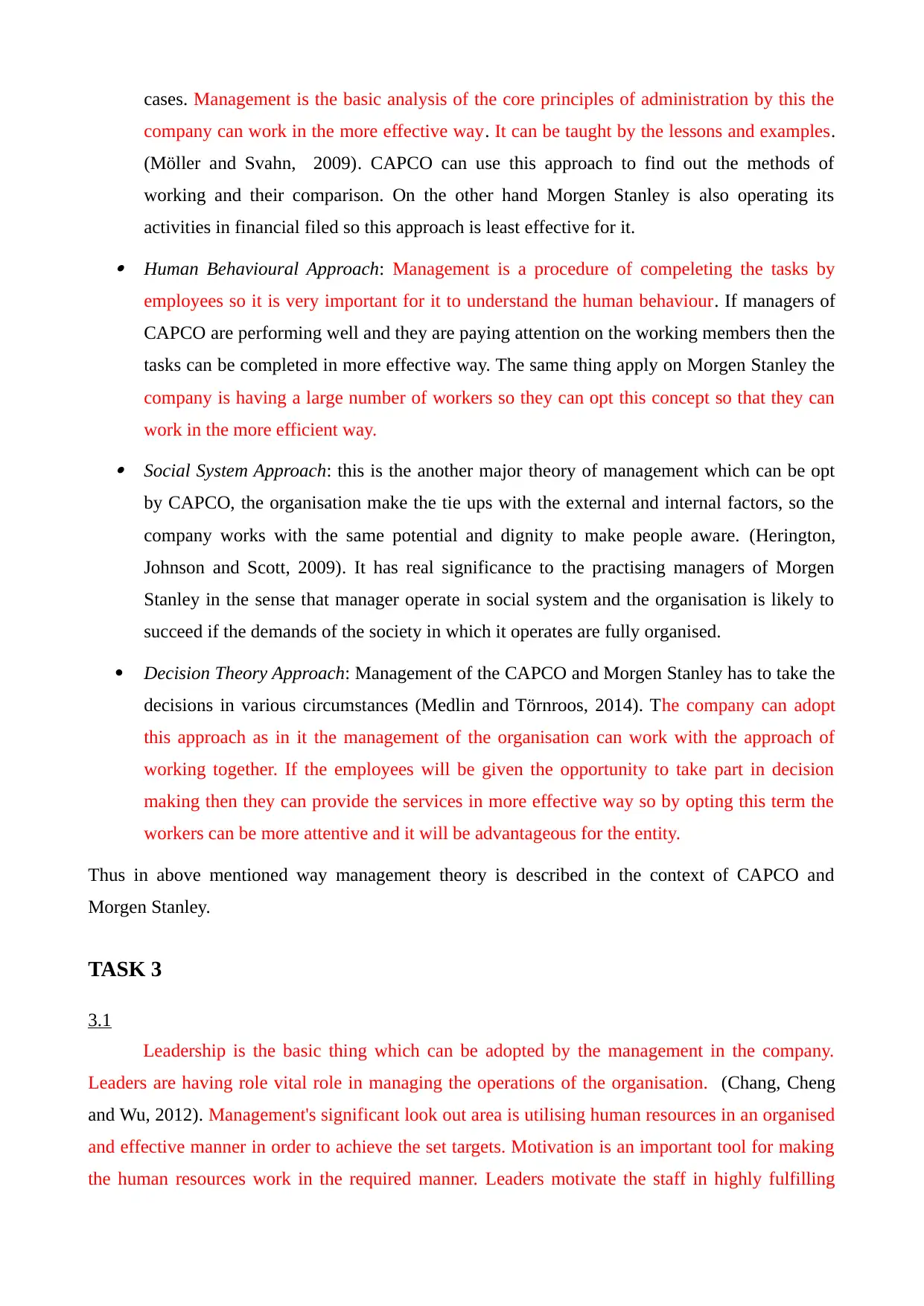
cases. Management is the basic analysis of the core principles of administration by this the
company can work in the more effective way. It can be taught by the lessons and examples.
(Möller and Svahn, 2009). CAPCO can use this approach to find out the methods of
working and their comparison. On the other hand Morgen Stanley is also operating its
activities in financial filed so this approach is least effective for it.
Human Behavioural Approach: Management is a procedure of compeleting the tasks by
employees so it is very important for it to understand the human behaviour. If managers of
CAPCO are performing well and they are paying attention on the working members then the
tasks can be completed in more effective way. The same thing apply on Morgen Stanley the
company is having a large number of workers so they can opt this concept so that they can
work in the more efficient way.
Social System Approach: this is the another major theory of management which can be opt
by CAPCO, the organisation make the tie ups with the external and internal factors, so the
company works with the same potential and dignity to make people aware. (Herington,
Johnson and Scott, 2009). It has real significance to the practising managers of Morgen
Stanley in the sense that manager operate in social system and the organisation is likely to
succeed if the demands of the society in which it operates are fully organised.
Decision Theory Approach: Management of the CAPCO and Morgen Stanley has to take the
decisions in various circumstances (Medlin and Törnroos, 2014). The company can adopt
this approach as in it the management of the organisation can work with the approach of
working together. If the employees will be given the opportunity to take part in decision
making then they can provide the services in more effective way so by opting this term the
workers can be more attentive and it will be advantageous for the entity.
Thus in above mentioned way management theory is described in the context of CAPCO and
Morgen Stanley.
TASK 3
3.1
Leadership is the basic thing which can be adopted by the management in the company.
Leaders are having role vital role in managing the operations of the organisation. (Chang, Cheng
and Wu, 2012). Management's significant look out area is utilising human resources in an organised
and effective manner in order to achieve the set targets. Motivation is an important tool for making
the human resources work in the required manner. Leaders motivate the staff in highly fulfilling
company can work in the more effective way. It can be taught by the lessons and examples.
(Möller and Svahn, 2009). CAPCO can use this approach to find out the methods of
working and their comparison. On the other hand Morgen Stanley is also operating its
activities in financial filed so this approach is least effective for it.
Human Behavioural Approach: Management is a procedure of compeleting the tasks by
employees so it is very important for it to understand the human behaviour. If managers of
CAPCO are performing well and they are paying attention on the working members then the
tasks can be completed in more effective way. The same thing apply on Morgen Stanley the
company is having a large number of workers so they can opt this concept so that they can
work in the more efficient way.
Social System Approach: this is the another major theory of management which can be opt
by CAPCO, the organisation make the tie ups with the external and internal factors, so the
company works with the same potential and dignity to make people aware. (Herington,
Johnson and Scott, 2009). It has real significance to the practising managers of Morgen
Stanley in the sense that manager operate in social system and the organisation is likely to
succeed if the demands of the society in which it operates are fully organised.
Decision Theory Approach: Management of the CAPCO and Morgen Stanley has to take the
decisions in various circumstances (Medlin and Törnroos, 2014). The company can adopt
this approach as in it the management of the organisation can work with the approach of
working together. If the employees will be given the opportunity to take part in decision
making then they can provide the services in more effective way so by opting this term the
workers can be more attentive and it will be advantageous for the entity.
Thus in above mentioned way management theory is described in the context of CAPCO and
Morgen Stanley.
TASK 3
3.1
Leadership is the basic thing which can be adopted by the management in the company.
Leaders are having role vital role in managing the operations of the organisation. (Chang, Cheng
and Wu, 2012). Management's significant look out area is utilising human resources in an organised
and effective manner in order to achieve the set targets. Motivation is an important tool for making
the human resources work in the required manner. Leaders motivate the staff in highly fulfilling
Paraphrase This Document
Need a fresh take? Get an instant paraphrase of this document with our AI Paraphraser
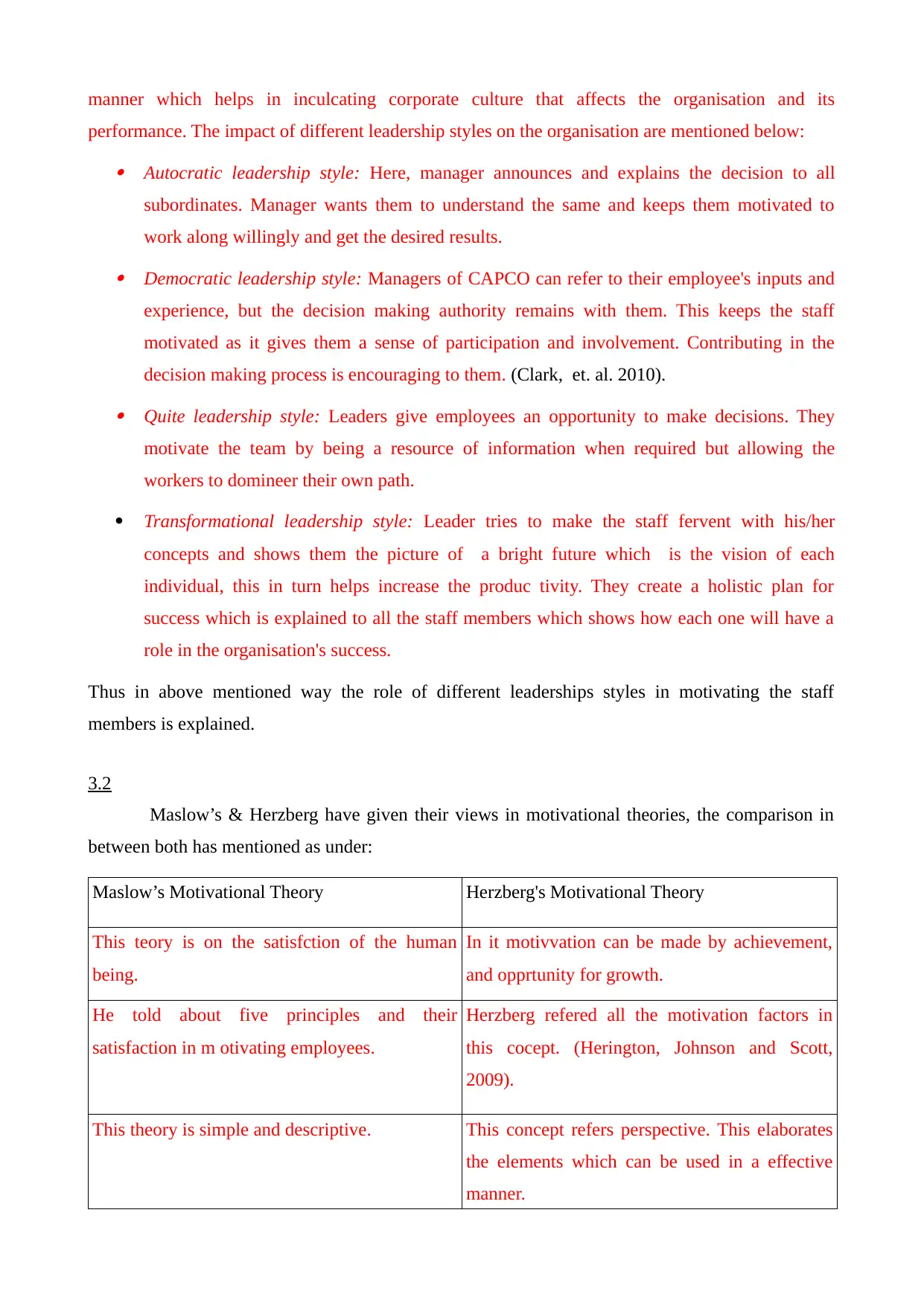
manner which helps in inculcating corporate culture that affects the organisation and its
performance. The impact of different leadership styles on the organisation are mentioned below:
Autocratic leadership style: Here, manager announces and explains the decision to all
subordinates. Manager wants them to understand the same and keeps them motivated to
work along willingly and get the desired results.
Democratic leadership style: Managers of CAPCO can refer to their employee's inputs and
experience, but the decision making authority remains with them. This keeps the staff
motivated as it gives them a sense of participation and involvement. Contributing in the
decision making process is encouraging to them. (Clark, et. al. 2010).
Quite leadership style: Leaders give employees an opportunity to make decisions. They
motivate the team by being a resource of information when required but allowing the
workers to domineer their own path.
Transformational leadership style: Leader tries to make the staff fervent with his/her
concepts and shows them the picture of a bright future which is the vision of each
individual, this in turn helps increase the produc tivity. They create a holistic plan for
success which is explained to all the staff members which shows how each one will have a
role in the organisation's success.
Thus in above mentioned way the role of different leaderships styles in motivating the staff
members is explained.
3.2
Maslow’s & Herzberg have given their views in motivational theories, the comparison in
between both has mentioned as under:
Maslow’s Motivational Theory Herzberg's Motivational Theory
This teory is on the satisfction of the human
being.
In it motivvation can be made by achievement,
and opprtunity for growth.
He told about five principles and their
satisfaction in m otivating employees.
Herzberg refered all the motivation factors in
this cocept. (Herington, Johnson and Scott,
2009).
This theory is simple and descriptive. This concept refers perspective. This elaborates
the elements which can be used in a effective
manner.
performance. The impact of different leadership styles on the organisation are mentioned below:
Autocratic leadership style: Here, manager announces and explains the decision to all
subordinates. Manager wants them to understand the same and keeps them motivated to
work along willingly and get the desired results.
Democratic leadership style: Managers of CAPCO can refer to their employee's inputs and
experience, but the decision making authority remains with them. This keeps the staff
motivated as it gives them a sense of participation and involvement. Contributing in the
decision making process is encouraging to them. (Clark, et. al. 2010).
Quite leadership style: Leaders give employees an opportunity to make decisions. They
motivate the team by being a resource of information when required but allowing the
workers to domineer their own path.
Transformational leadership style: Leader tries to make the staff fervent with his/her
concepts and shows them the picture of a bright future which is the vision of each
individual, this in turn helps increase the produc tivity. They create a holistic plan for
success which is explained to all the staff members which shows how each one will have a
role in the organisation's success.
Thus in above mentioned way the role of different leaderships styles in motivating the staff
members is explained.
3.2
Maslow’s & Herzberg have given their views in motivational theories, the comparison in
between both has mentioned as under:
Maslow’s Motivational Theory Herzberg's Motivational Theory
This teory is on the satisfction of the human
being.
In it motivvation can be made by achievement,
and opprtunity for growth.
He told about five principles and their
satisfaction in m otivating employees.
Herzberg refered all the motivation factors in
this cocept. (Herington, Johnson and Scott,
2009).
This theory is simple and descriptive. This concept refers perspective. This elaborates
the elements which can be used in a effective
manner.
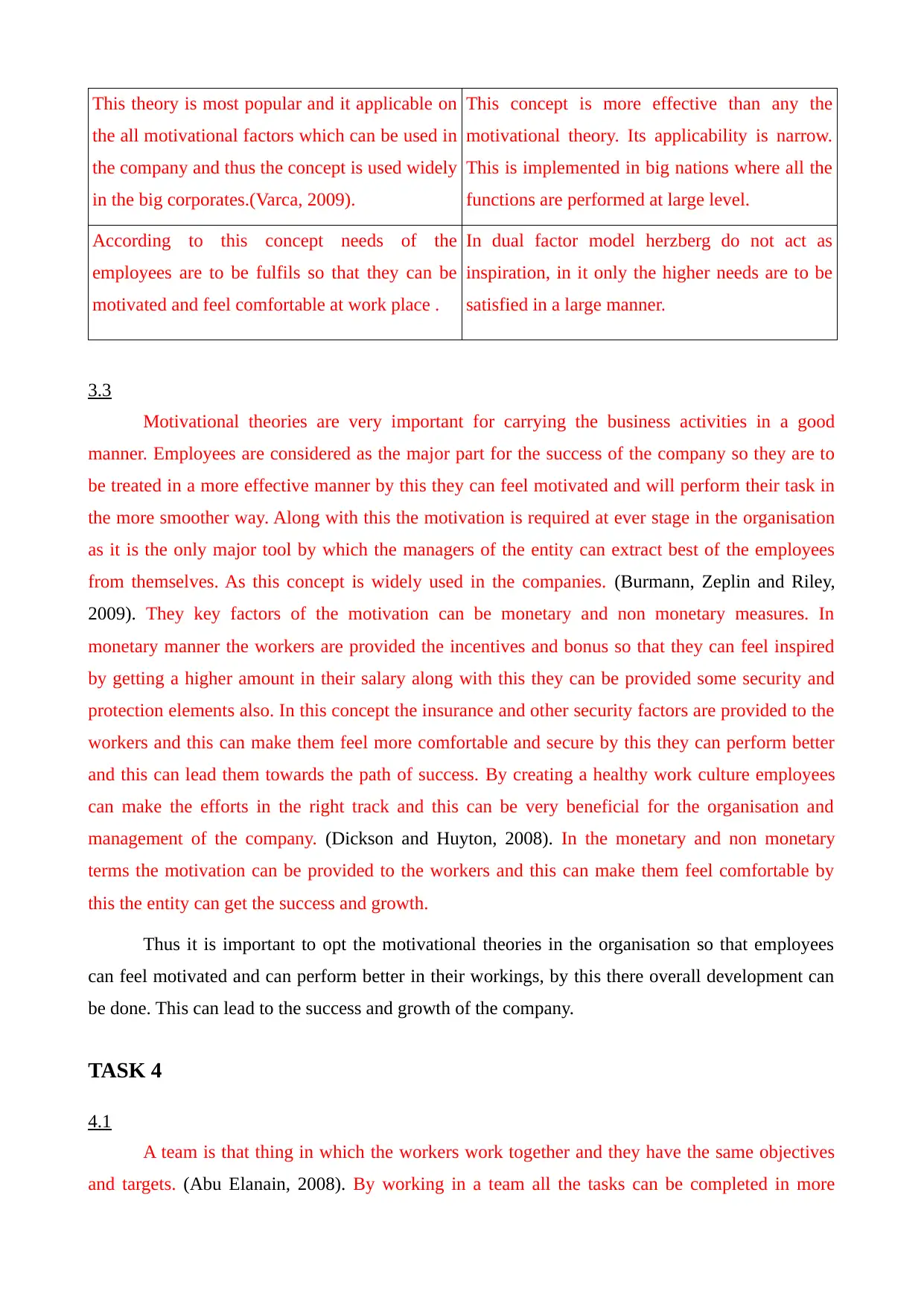
This theory is most popular and it applicable on
the all motivational factors which can be used in
the company and thus the concept is used widely
in the big corporates.(Varca, 2009).
This concept is more effective than any the
motivational theory. Its applicability is narrow.
This is implemented in big nations where all the
functions are performed at large level.
According to this concept needs of the
employees are to be fulfils so that they can be
motivated and feel comfortable at work place .
In dual factor model herzberg do not act as
inspiration, in it only the higher needs are to be
satisfied in a large manner.
3.3
Motivational theories are very important for carrying the business activities in a good
manner. Employees are considered as the major part for the success of the company so they are to
be treated in a more effective manner by this they can feel motivated and will perform their task in
the more smoother way. Along with this the motivation is required at ever stage in the organisation
as it is the only major tool by which the managers of the entity can extract best of the employees
from themselves. As this concept is widely used in the companies. (Burmann, Zeplin and Riley,
2009). They key factors of the motivation can be monetary and non monetary measures. In
monetary manner the workers are provided the incentives and bonus so that they can feel inspired
by getting a higher amount in their salary along with this they can be provided some security and
protection elements also. In this concept the insurance and other security factors are provided to the
workers and this can make them feel more comfortable and secure by this they can perform better
and this can lead them towards the path of success. By creating a healthy work culture employees
can make the efforts in the right track and this can be very beneficial for the organisation and
management of the company. (Dickson and Huyton, 2008). In the monetary and non monetary
terms the motivation can be provided to the workers and this can make them feel comfortable by
this the entity can get the success and growth.
Thus it is important to opt the motivational theories in the organisation so that employees
can feel motivated and can perform better in their workings, by this there overall development can
be done. This can lead to the success and growth of the company.
TASK 4
4.1
A team is that thing in which the workers work together and they have the same objectives
and targets. (Abu Elanain, 2008). By working in a team all the tasks can be completed in more
the all motivational factors which can be used in
the company and thus the concept is used widely
in the big corporates.(Varca, 2009).
This concept is more effective than any the
motivational theory. Its applicability is narrow.
This is implemented in big nations where all the
functions are performed at large level.
According to this concept needs of the
employees are to be fulfils so that they can be
motivated and feel comfortable at work place .
In dual factor model herzberg do not act as
inspiration, in it only the higher needs are to be
satisfied in a large manner.
3.3
Motivational theories are very important for carrying the business activities in a good
manner. Employees are considered as the major part for the success of the company so they are to
be treated in a more effective manner by this they can feel motivated and will perform their task in
the more smoother way. Along with this the motivation is required at ever stage in the organisation
as it is the only major tool by which the managers of the entity can extract best of the employees
from themselves. As this concept is widely used in the companies. (Burmann, Zeplin and Riley,
2009). They key factors of the motivation can be monetary and non monetary measures. In
monetary manner the workers are provided the incentives and bonus so that they can feel inspired
by getting a higher amount in their salary along with this they can be provided some security and
protection elements also. In this concept the insurance and other security factors are provided to the
workers and this can make them feel more comfortable and secure by this they can perform better
and this can lead them towards the path of success. By creating a healthy work culture employees
can make the efforts in the right track and this can be very beneficial for the organisation and
management of the company. (Dickson and Huyton, 2008). In the monetary and non monetary
terms the motivation can be provided to the workers and this can make them feel comfortable by
this the entity can get the success and growth.
Thus it is important to opt the motivational theories in the organisation so that employees
can feel motivated and can perform better in their workings, by this there overall development can
be done. This can lead to the success and growth of the company.
TASK 4
4.1
A team is that thing in which the workers work together and they have the same objectives
and targets. (Abu Elanain, 2008). By working in a team all the tasks can be completed in more
⊘ This is a preview!⊘
Do you want full access?
Subscribe today to unlock all pages.

Trusted by 1+ million students worldwide
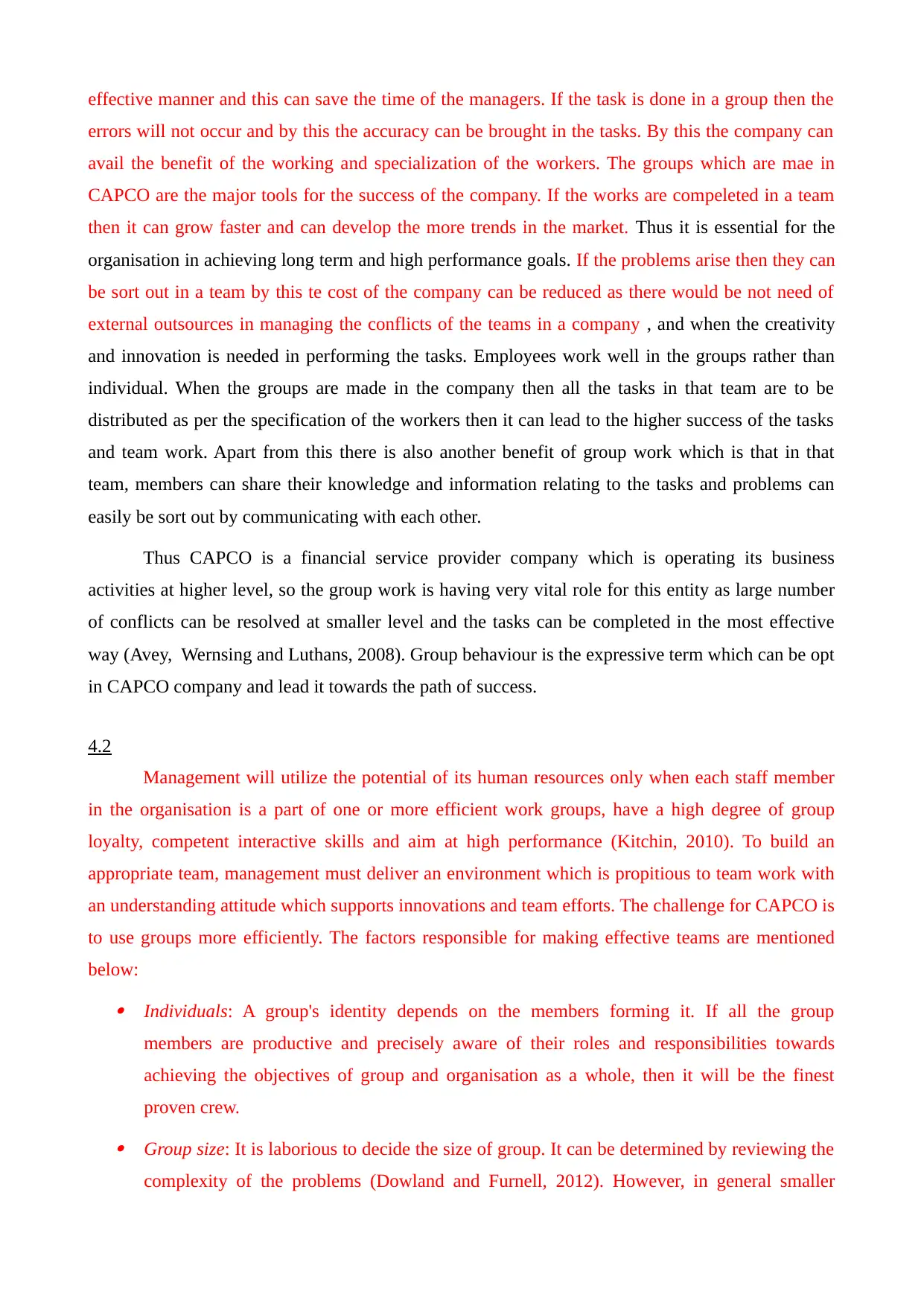
effective manner and this can save the time of the managers. If the task is done in a group then the
errors will not occur and by this the accuracy can be brought in the tasks. By this the company can
avail the benefit of the working and specialization of the workers. The groups which are mae in
CAPCO are the major tools for the success of the company. If the works are compeleted in a team
then it can grow faster and can develop the more trends in the market. Thus it is essential for the
organisation in achieving long term and high performance goals. If the problems arise then they can
be sort out in a team by this te cost of the company can be reduced as there would be not need of
external outsources in managing the conflicts of the teams in a company , and when the creativity
and innovation is needed in performing the tasks. Employees work well in the groups rather than
individual. When the groups are made in the company then all the tasks in that team are to be
distributed as per the specification of the workers then it can lead to the higher success of the tasks
and team work. Apart from this there is also another benefit of group work which is that in that
team, members can share their knowledge and information relating to the tasks and problems can
easily be sort out by communicating with each other.
Thus CAPCO is a financial service provider company which is operating its business
activities at higher level, so the group work is having very vital role for this entity as large number
of conflicts can be resolved at smaller level and the tasks can be completed in the most effective
way (Avey, Wernsing and Luthans, 2008). Group behaviour is the expressive term which can be opt
in CAPCO company and lead it towards the path of success.
4.2
Management will utilize the potential of its human resources only when each staff member
in the organisation is a part of one or more efficient work groups, have a high degree of group
loyalty, competent interactive skills and aim at high performance (Kitchin, 2010). To build an
appropriate team, management must deliver an environment which is propitious to team work with
an understanding attitude which supports innovations and team efforts. The challenge for CAPCO is
to use groups more efficiently. The factors responsible for making effective teams are mentioned
below:
Individuals: A group's identity depends on the members forming it. If all the group
members are productive and precisely aware of their roles and responsibilities towards
achieving the objectives of group and organisation as a whole, then it will be the finest
proven crew.
Group size: It is laborious to decide the size of group. It can be determined by reviewing the
complexity of the problems (Dowland and Furnell, 2012). However, in general smaller
errors will not occur and by this the accuracy can be brought in the tasks. By this the company can
avail the benefit of the working and specialization of the workers. The groups which are mae in
CAPCO are the major tools for the success of the company. If the works are compeleted in a team
then it can grow faster and can develop the more trends in the market. Thus it is essential for the
organisation in achieving long term and high performance goals. If the problems arise then they can
be sort out in a team by this te cost of the company can be reduced as there would be not need of
external outsources in managing the conflicts of the teams in a company , and when the creativity
and innovation is needed in performing the tasks. Employees work well in the groups rather than
individual. When the groups are made in the company then all the tasks in that team are to be
distributed as per the specification of the workers then it can lead to the higher success of the tasks
and team work. Apart from this there is also another benefit of group work which is that in that
team, members can share their knowledge and information relating to the tasks and problems can
easily be sort out by communicating with each other.
Thus CAPCO is a financial service provider company which is operating its business
activities at higher level, so the group work is having very vital role for this entity as large number
of conflicts can be resolved at smaller level and the tasks can be completed in the most effective
way (Avey, Wernsing and Luthans, 2008). Group behaviour is the expressive term which can be opt
in CAPCO company and lead it towards the path of success.
4.2
Management will utilize the potential of its human resources only when each staff member
in the organisation is a part of one or more efficient work groups, have a high degree of group
loyalty, competent interactive skills and aim at high performance (Kitchin, 2010). To build an
appropriate team, management must deliver an environment which is propitious to team work with
an understanding attitude which supports innovations and team efforts. The challenge for CAPCO is
to use groups more efficiently. The factors responsible for making effective teams are mentioned
below:
Individuals: A group's identity depends on the members forming it. If all the group
members are productive and precisely aware of their roles and responsibilities towards
achieving the objectives of group and organisation as a whole, then it will be the finest
proven crew.
Group size: It is laborious to decide the size of group. It can be determined by reviewing the
complexity of the problems (Dowland and Furnell, 2012). However, in general smaller
Paraphrase This Document
Need a fresh take? Get an instant paraphrase of this document with our AI Paraphraser
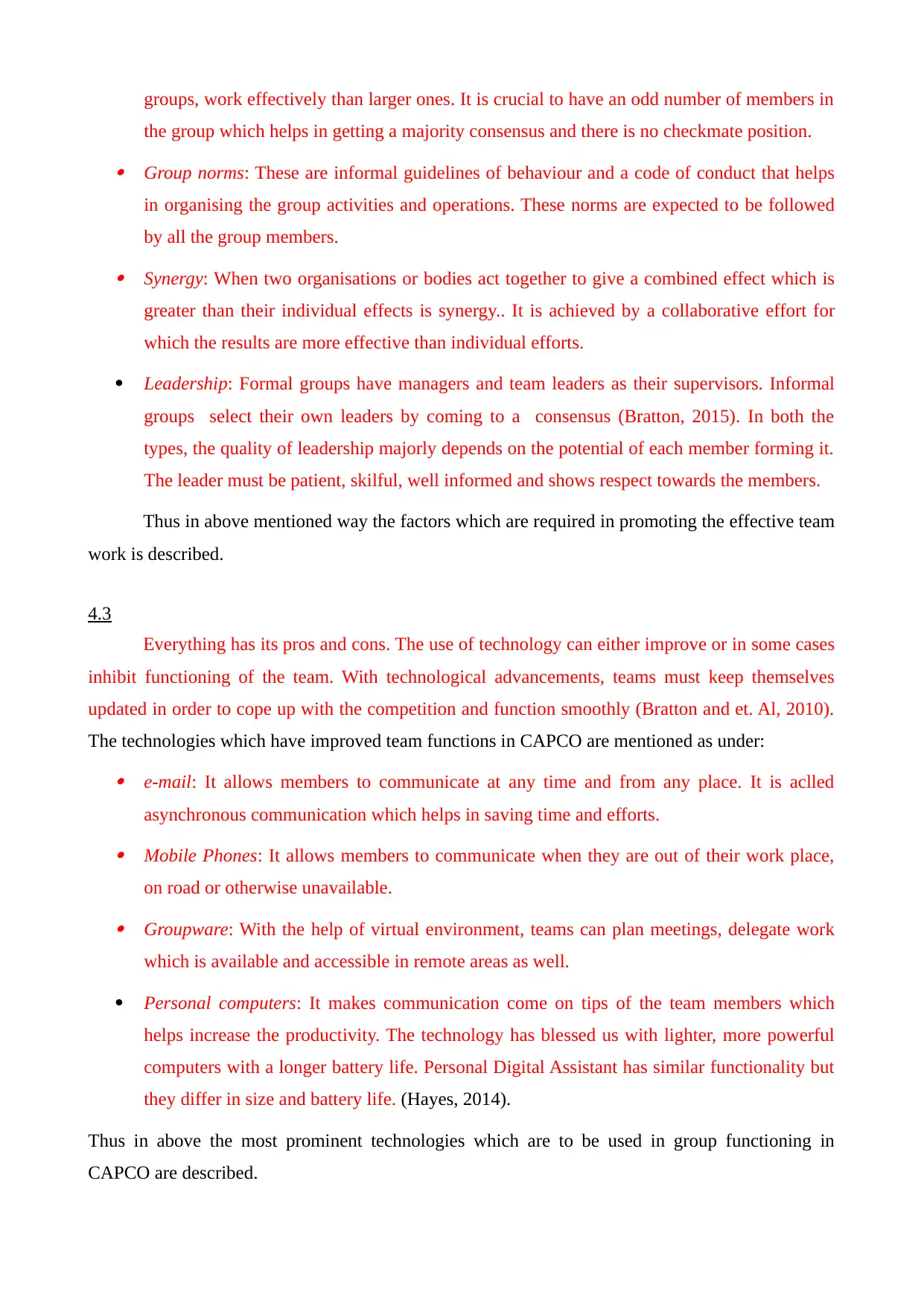
groups, work effectively than larger ones. It is crucial to have an odd number of members in
the group which helps in getting a majority consensus and there is no checkmate position.
Group norms: These are informal guidelines of behaviour and a code of conduct that helps
in organising the group activities and operations. These norms are expected to be followed
by all the group members.
Synergy: When two organisations or bodies act together to give a combined effect which is
greater than their individual effects is synergy.. It is achieved by a collaborative effort for
which the results are more effective than individual efforts.
Leadership: Formal groups have managers and team leaders as their supervisors. Informal
groups select their own leaders by coming to a consensus (Bratton, 2015). In both the
types, the quality of leadership majorly depends on the potential of each member forming it.
The leader must be patient, skilful, well informed and shows respect towards the members.
Thus in above mentioned way the factors which are required in promoting the effective team
work is described.
4.3
Everything has its pros and cons. The use of technology can either improve or in some cases
inhibit functioning of the team. With technological advancements, teams must keep themselves
updated in order to cope up with the competition and function smoothly (Bratton and et. Al, 2010).
The technologies which have improved team functions in CAPCO are mentioned as under:
e-mail: It allows members to communicate at any time and from any place. It is aclled
asynchronous communication which helps in saving time and efforts.
Mobile Phones: It allows members to communicate when they are out of their work place,
on road or otherwise unavailable.
Groupware: With the help of virtual environment, teams can plan meetings, delegate work
which is available and accessible in remote areas as well.
Personal computers: It makes communication come on tips of the team members which
helps increase the productivity. The technology has blessed us with lighter, more powerful
computers with a longer battery life. Personal Digital Assistant has similar functionality but
they differ in size and battery life. (Hayes, 2014).
Thus in above the most prominent technologies which are to be used in group functioning in
CAPCO are described.
the group which helps in getting a majority consensus and there is no checkmate position.
Group norms: These are informal guidelines of behaviour and a code of conduct that helps
in organising the group activities and operations. These norms are expected to be followed
by all the group members.
Synergy: When two organisations or bodies act together to give a combined effect which is
greater than their individual effects is synergy.. It is achieved by a collaborative effort for
which the results are more effective than individual efforts.
Leadership: Formal groups have managers and team leaders as their supervisors. Informal
groups select their own leaders by coming to a consensus (Bratton, 2015). In both the
types, the quality of leadership majorly depends on the potential of each member forming it.
The leader must be patient, skilful, well informed and shows respect towards the members.
Thus in above mentioned way the factors which are required in promoting the effective team
work is described.
4.3
Everything has its pros and cons. The use of technology can either improve or in some cases
inhibit functioning of the team. With technological advancements, teams must keep themselves
updated in order to cope up with the competition and function smoothly (Bratton and et. Al, 2010).
The technologies which have improved team functions in CAPCO are mentioned as under:
e-mail: It allows members to communicate at any time and from any place. It is aclled
asynchronous communication which helps in saving time and efforts.
Mobile Phones: It allows members to communicate when they are out of their work place,
on road or otherwise unavailable.
Groupware: With the help of virtual environment, teams can plan meetings, delegate work
which is available and accessible in remote areas as well.
Personal computers: It makes communication come on tips of the team members which
helps increase the productivity. The technology has blessed us with lighter, more powerful
computers with a longer battery life. Personal Digital Assistant has similar functionality but
they differ in size and battery life. (Hayes, 2014).
Thus in above the most prominent technologies which are to be used in group functioning in
CAPCO are described.

CONCLUSION
In the report it is described that the team work is very important for managing all the
operational activities in smoother way. In order to conserve effectiveness of the group, each
individual should be aware of crucial stages and methods in order to avoid getting stuck along the
way. Along with this it also concluded that varied leadership skills integrated with knowledge of
team development will help teams perform in a highly fulfilling manner. Apart from this the role of
motivation is also discussed in the above report and it is extracted that inspiration at work place can
assist the employees in providing their best to CAPCO and this can be useful for them also as their
development can be done. Thus the above study concludes that a good organisational behaviour is
the boon for the entity in making it prosperous and successful.
In the report it is described that the team work is very important for managing all the
operational activities in smoother way. In order to conserve effectiveness of the group, each
individual should be aware of crucial stages and methods in order to avoid getting stuck along the
way. Along with this it also concluded that varied leadership skills integrated with knowledge of
team development will help teams perform in a highly fulfilling manner. Apart from this the role of
motivation is also discussed in the above report and it is extracted that inspiration at work place can
assist the employees in providing their best to CAPCO and this can be useful for them also as their
development can be done. Thus the above study concludes that a good organisational behaviour is
the boon for the entity in making it prosperous and successful.
⊘ This is a preview!⊘
Do you want full access?
Subscribe today to unlock all pages.

Trusted by 1+ million students worldwide
1 out of 14
Related Documents
Your All-in-One AI-Powered Toolkit for Academic Success.
+13062052269
info@desklib.com
Available 24*7 on WhatsApp / Email
![[object Object]](/_next/static/media/star-bottom.7253800d.svg)
Unlock your academic potential
Copyright © 2020–2025 A2Z Services. All Rights Reserved. Developed and managed by ZUCOL.





